Schools of landscape painting are often driven by political struggles for independence, and Norway’s is no exception. Between 1380 and 1814, Norway was an impoverished and oppressed land ruled over by Denmark. In the redrawing of the map of Europe after the defeat of Napoleon, Norway still did not gain its independence but was forced into union with Sweden under Karl Johan who tactlessly had his palace in Oslo built by gangs of Norwegian prisoners in chains.
At the time of these post-Napoleonic European convulsions, Johan Christian Dahl (1788–1857), known as ‘the father of Norwegian painting’, was studying at the Art Academy in Denmark and travelling widely. (Norway did not have its own art academy, let alone a national gallery.) Norway had been partially recorded topographically and a few intrepid Danish artists had undertaken minor painting tours, but despite the 18th century’s fascination with Alpinism and ‘gothick gloomth’, Norway’s vertiginous peaks and thundering torrents remained undiscovered by the European Romantic movement, and unpainted.
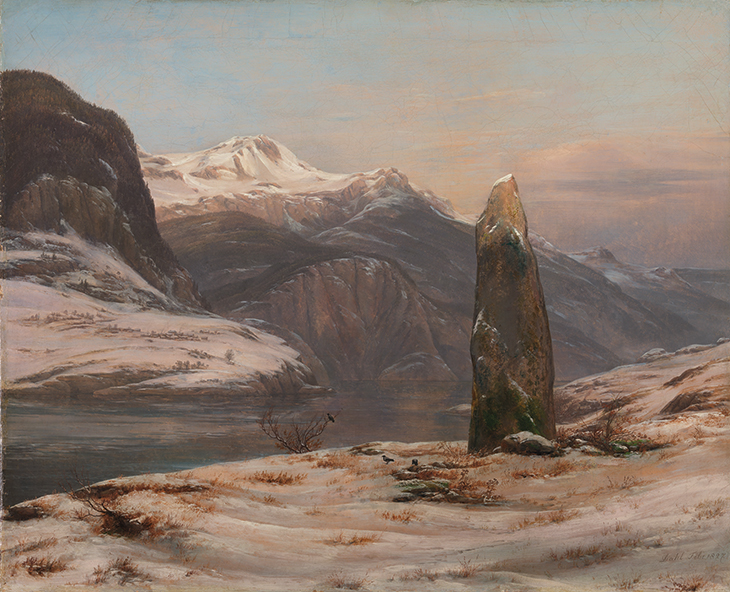
Winter at the Sognefjord (1827), Johan Christian Dahl. National Museum of Art, Architecture and Design, Oslo
As a student in Copenhagen, Dahl saw Dutch landscapes. In 1818 he moved to Dresden where the great Romantic painter Caspar David Friedrich (1744–1840) was at the height of his powers. The two men became housemates and close friends. In 1821 Dahl visited Rome and sketched in the Campagna, where he realised the mythologising potential of landscape. Both painters produced their sweeping canvases in the studio, but while Friedrich continued to take the local landscape as his subject and transform it though his spiritual vision, Dahl painted visions of Norway, translating the peaks of the Sognefjord, the thundering Labro torrent and other recognisable Norwegian beauty spots into a new, impressive and turbulent vision of a northern Arcadia.
Dahl found it much easier to portray his country from abroad (as Henrik Ibsen did a generation later). As his fame grew he remained in Dresden where he taught at the Academy, but he did not forget the plight of his fellow countrymen. In the 1830s he was instrumental in founding both the National Gallery of Norway and the Norwegian Art Association. Norwegian artists could now see real examples of world art in a gallery, rather than poring over books of prints and engravings. The Art Association gave them a meeting place where they could discuss their own work in the context of their European contemporaries. A national school gradually formed.
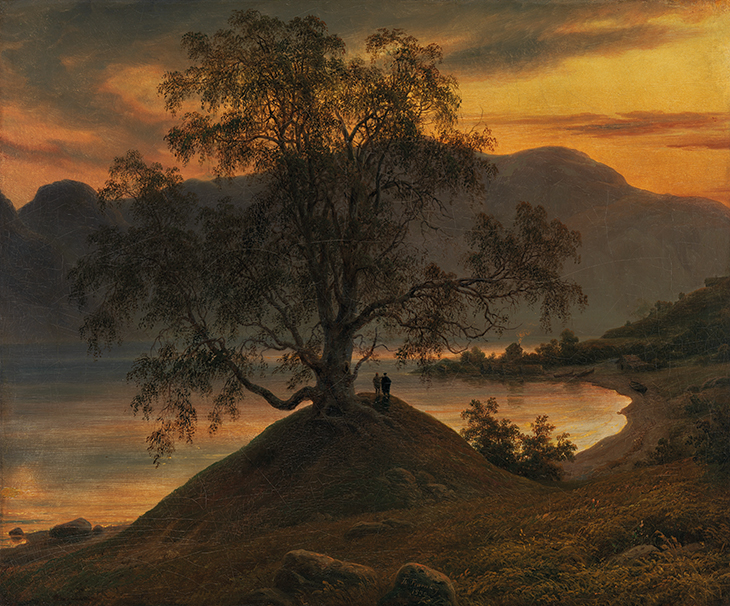
Old Birch Tree at the Sognefjord (1839), Thomas Fearnley. National Museum of Art, Architecture and Design, Oslo
Dahl’s studio in Dresden became a place of pilgrimage for Norwegian painters who wanted to build on the German Romantic tradition. The clear line from Friedrich can be seen in Old Birch Tree at the Sognefjord (1839) by Thomas Fearnley (1802–42), a clever progression from Friedrich’s famous The Wanderer above the Sea of Fog (1818). In the latter the individual human hero stands strong and straight against a tempestuous background, but Fearnley replaces the human figure with an ancient birch tree, symbolising Norway. Composition, theme, spirituality and yearning are similar in both paintings but Fearnley moves the message away from Romantic individualism and towards nationalist symbolism.
The nationalist theme was taken up by Adolf Tidemand, who peopled his landscapes with depressed and depressing peasants. Hans F. Gude and August Capellen, who both taught at the Düsseldorf Academy, returned the focus to pure landscape. Capellen and Lars Hertevig, a pupil of Gude in Düsseldorf, ventured more timidly into the sublime, unmooring their pictures from specific Norwegian locations to give them generic titles such as Decaying Forest (1852) and Thunder Looms (1856). Fearnley’s lone birch tree as symbol of Norway was further developed by Eilif Peterssen in Summer Night (1888), an informal composition of a birch fallen across a sheet of water. Consciously or unconsciously, nationalism in art had progressed from a first stage of carefully composed, idealised set pieces to portraying a slice of reality to which every citizen could relate; any countryman might glimpse something very like the casual beauty depicted in Peterssen’s Summer Night on an evening walk.
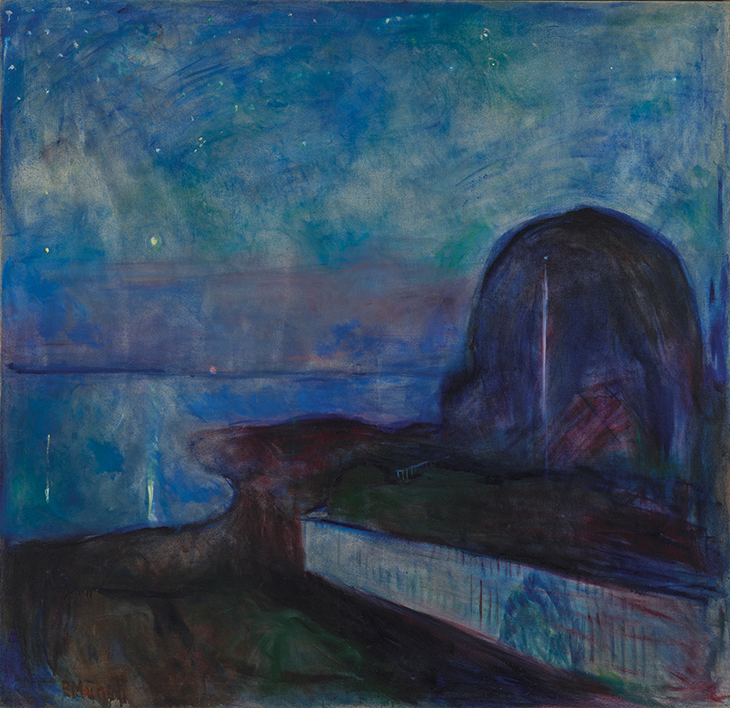
Starry Night (1893), Edvard Munch. J. Paul Getty Museum, Los Angeles
While Peterssen, Fearnley and others were moving towards more realistic observation, Peder Balke (1804–87) was moving in the other direction, towards the imaginative sublime. For a century Norwegian landscape would continue on both paths. Naturalistic and symbolic-visionary approaches existed side by side and only rare artists, such as Edvard Munch, would dip in and out of both.
Balke was a loner drawn to the furthest north, which he invested with a gothic intensity. His best pictures are tiny and very personal observations of vast and threatening scenes: ice floes, tossing seas, vertiginous cliffs, often weirdly illuminated by silvery moonlight or by the scribble of the Northern Lights in the sky. Mystical and often tempestuous, Balke’s vision of the magnificent, coldly indifferent motherland offers no comfort, but demands sacrifice and worship. Balke’s technique eschews careful finish. Sometimes he applied the paint with his hands; often he painted in monochrome, in tones of blue or brown, or just black and white. At a first glance it is possible to take his small, improvisational oils on panel for early photographs. Some areas are misty and faded out, others sharply in focus. Balke made no attempt at naturalism. His landscapes are often empty: solitary figures, lighthouses, lone trees or boats in obvious peril are only there to emphasise the ineluctable power of nature and the heroic North. He records impersonally, ostensibly avoiding emotional manipulation, but for all that, his landscapes pack a powerful punch, the strongest in Norwegian painting until Munch.
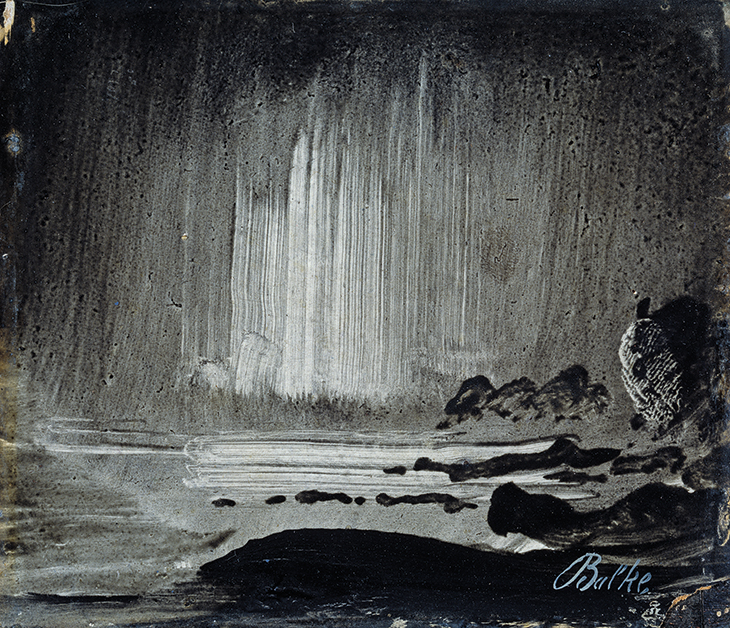
Northern Lights over Coastal Landscape (c. 1870), Peder Balke. National Museum of Art, Architecture and Design, Oslo
As Balke was active in the 1830s and ’40s, the Norwegian folk movement was in full, nationalistic swing. Olaf Isaachsen was a painter who was well-versed internationally, having studied first in Düsseldorf and then in France under Couture and Courbet. His landscapes feature peasants in colourful national dress; he even felt it important to record unpeopled peasant interiors. The folklorists Asbjørnsen and Moe, who tramped the very long length of Norway collecting tales from thousands of isolated valleys, published their Norwegian Folk Tales in the Norwegian language in 1841. This was a major political act. Throughout the preceding four centuries Norway’s official written language had been Danish, a bureaucratic arrangement that had deprived the Norwegian people of widespread literacy, let alone literature. Norwegian Folk Tales was illustrated by Erik Werenskiold (1855–1938) and Theodor Kittelsen (1857–1914), and the two artists gave graphic physical shape to the terrifying creatures that haunted the Norwegian imagination. They created the folkloric archetypes that endure to this day: the troll that gurns at you from every tourist trap, and Kittelsen’s subtler and more terrifying Skogtroll, the forest troll (1888) who takes the form of an anthropomorphised mountain.
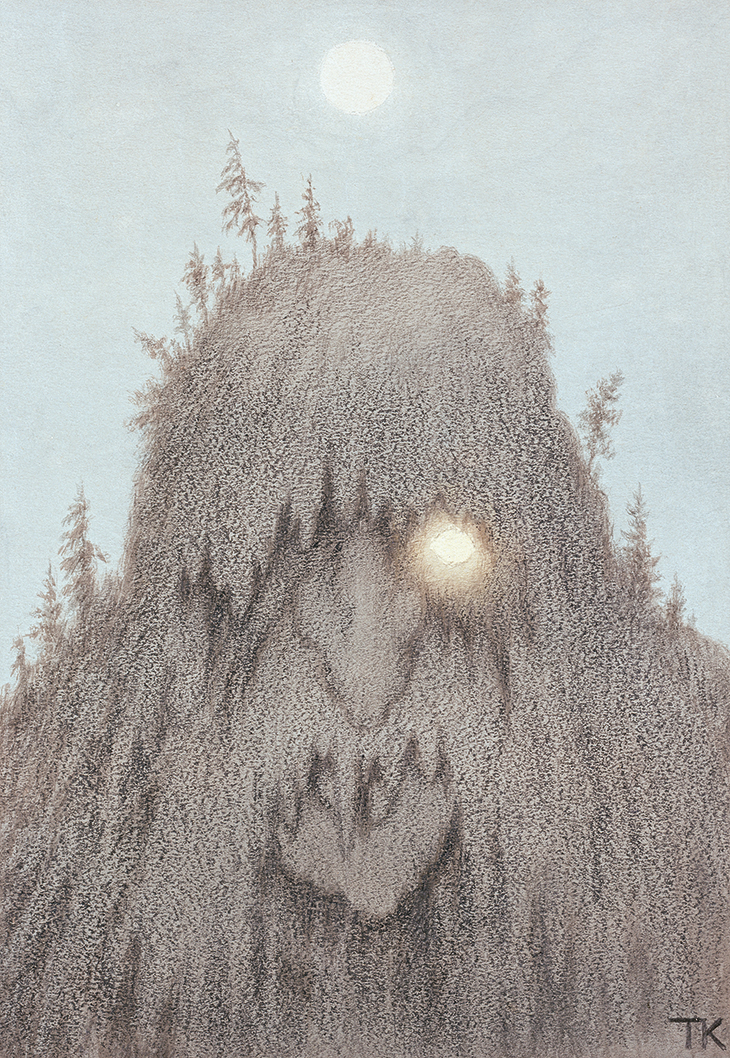
Forest Troll (1906), Theodor Kittelsen. National Museum of Art, Architecture and Design, Oslo
By the 1880s, Norway still had not achieved independence but its artistic compass had moved from Germany to France. Young painters were becoming sceptical of rigid German academic training, and bohemian Paris beckoned. Here, at last, Norwegian culture was wielding a wider influence. Ibsen’s plays were all the rage in Paris, where Frits Thaulow (1847–1906) was celebrated as ‘the painter of snow’. Thaulow had no strong nationalist agenda but his luminous landscapes inspired Monet to visit Norway in 1895, where the Frenchman had terrible trouble with his paint freezing. French influence grew in turn as Thaulow came home in the summers to pioneer plein air painting at his Open Air Academy in Modum.
Christian Krohg (1852–1925) is not in the front rank of Norwegian artists but he was very important at a time when their attention was turning to Paris, and to French Impressionism. Krohg taught in Paris at the Académie Colarossi; his style was realist, his convictions socialist and his subjects unashamedly political. Ragged urchins, defiant prostitutes and heroic sea captains in sou’westers represent Norway’s poverty and injustice. In 1882, Krohg attended the seventh and largest Impressionist exhibition and returned to Norway the same year brimming with ideas. He organised the first exhibition of independent artists in Oslo and opened an art school where Impressionism and pointillism were discussed and tried out. His pupils for a time included the young Edvard Munch (1863–1944). When Munch exhibited a pointilliste canvas in Oslo – Spring Day on Karl Johan Street (1890) – Norwegian doctors earnestly warned the public against looking at it, believing they could catch spotty diseases, such as measles and chicken pox from a mere glance.
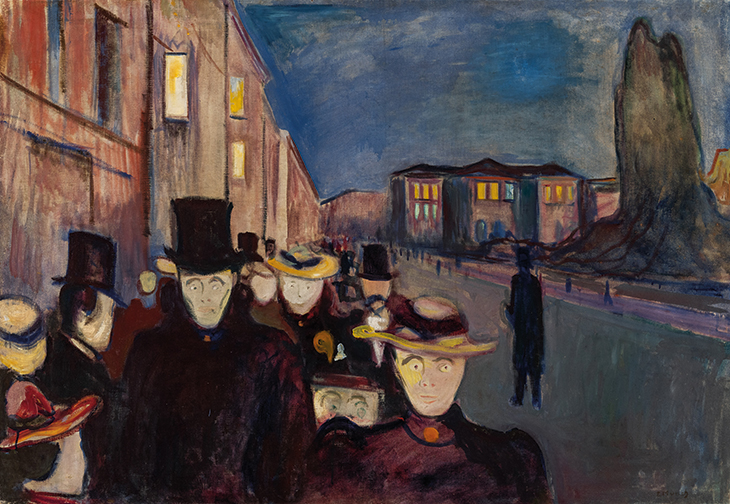
Evening on Karl Johan (1892–94), Edvard Munch. Bergen Kunstmuseum
Munch soon outgrew Krohg, pointillism and all other -isms to paint his completely original landscapes. In 1885, he had paid the first of several long visits to Paris. The following year the French poet Jean Moréas published his Symbolist Manifesto in Le Figaro. Moréas attacked naturalism, urging writers and artists to be more evocative and suggestive in their response to nature. Munch wrote in his journal: ‘If it is possible to produce the desired effect by changing nature, then it should be done… Whether the picture resembles nature or not is irrelevant, as a picture cannot be explained; the reason for its being painted in the first place was that the artist could find no other means of expressing what he saw.’ In Paris Munch was strongly impressed by Puvis de Chavannes and by Gauguin’s flattening of space, simplification of forms and non-naturalistic use of colour, all of which we can see in curiously static and serene symbolist landscapes, such as Starry Night (1893; Fig. 6), which offer a dreamy, mystic view of the world. Munch had seen the Van Gogh retrospective of 1891, and the influence of the Dutch artist’s hectically directional brushwork can be detected in Munch’s best-known works, the troubled and turbulent paintings all created around 1893, such as Anxiety, or Evening on Karl Johan or The Scream. These are not the first paintings one would think of as landscapes but place is overwhelmingly significant to Munch, and in these great Expressionist canvases, recognisable landscapes play as important a part as the figures. In Munch’s written account of the vision that inspired The Scream, he relates how he saw the ‘clouds over the fjord drip[ped] reeking blood’ as he heard ‘a huge, extraordinary scream pass through nature’. He does not even mention the role of the figure in the painting, although today people see it as the main focus.
Norway achieved independence in 1905. ‘Yes, we love this land!’ runs the first line of the national anthem, celebrating the country in both senses of the word. That same year, Harald Sohlberg (1869–1935) produced Flower Meadow in the North, hymning Norway’s pastoral bliss and speaking of release, fecundity and a limitless national vision.
‘I have felt nature’s enigmatic and incomprehensible side and I have instinctively sought to know and understand it,’ Solhberg wrote in the late 1880s. Sohlberg’s landscapes, like those of his contemporary Munch, were metaphors for deep feelings, but his technique for conveying them could hardly be more different. Munch’s emotional punch is heightened by the impression that he painted at vast speed: paint dribbles and splodges and patches of naked canvas contribute to the idea of hastily conveyed inner turmoil. But Sohlberg, who had been apprenticed to a scene painter, employed the craftsman’s careful scaling up from meticulous preparatory drawings on to the canvas using a grid. He also used the old-fashioned glazing technique, carefully building up thin layers of almost transparent paint over coloured underlays. Sohlberg might take two years over a painting; nevertheless, he too aimed at immediate emotional punch. Like Munch, Sohlberg was influenced by Gauguin’s flattening of space, anti-naturalistic use of colour and synthesist rhythmic patterns. Sohlberg’s simplified and evocative landscapes defy definition, hovering between naturalism, symbolism and Fauvism in their strong and often vividly contrasting colours.
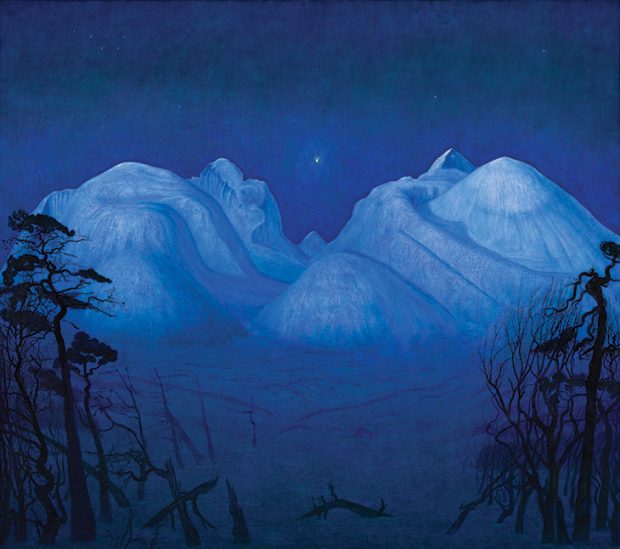
Winter Night in the Mountains (1914), Harald Sohlberg. National Museum of Art, Architecture and Design, Oslo
Sohlberg’s landscapes of mood and memory are nourished by feelings of isolation, separation and the spiritual yearning attendant on the arrival of the machine age and the departure of God. He found his two great recurring themes in the mystical untouched splendour of the Rondane mountains, a major Symbolist-Romantic subject into which he infused intense lyricism. In contrast, he took Røros, a copper-mining town, as a symbol of the industrial revolution creeping through Norway, corrupting the land and diminishing humanity. He paints the long Røros high street in overly bright, flat light, in perfectly enamelled finish and in obsessive detail. You can count every plank on every wooden house. Objectively, the street is undeniably picturesque, yet the insistent clarity makes the subject repellent: in forcing the material world upon the viewer Sohlberg is showing us that the world de-souled is not a sympathetic place. A contemporary critic observed that Sohlberg does not so much show us a picture of a street as the foreboding before a storm.
From the 1820s onwards, when J.C. Dahl began to shape an image of Norway, its artists have celebrated the country in diverse ways. In a recent poll, Sohlberg’s vision of the Rondane mountains, Winter Night in the Mountains (1914), was voted Norway’s favourite painting. Sohlberg and Munch were the two artists who finally freed Norwegian art from the influence of both Germany and France and gave it a vision of itself. By ditching nationalism, they laid the foundations for a true national art.
‘Harald Sohlberg: Painting Norway’ is at the Dulwich Picture Gallery until 2 June. ‘Edvard Munch: Love and Angst’ is at the British Museum until 21 July.
From the April 2019 issue of Apollo. Preview and subscribe here.
Unlimited access from just $16 every 3 months
Subscribe to get unlimited and exclusive access to the top art stories, interviews and exhibition reviews.

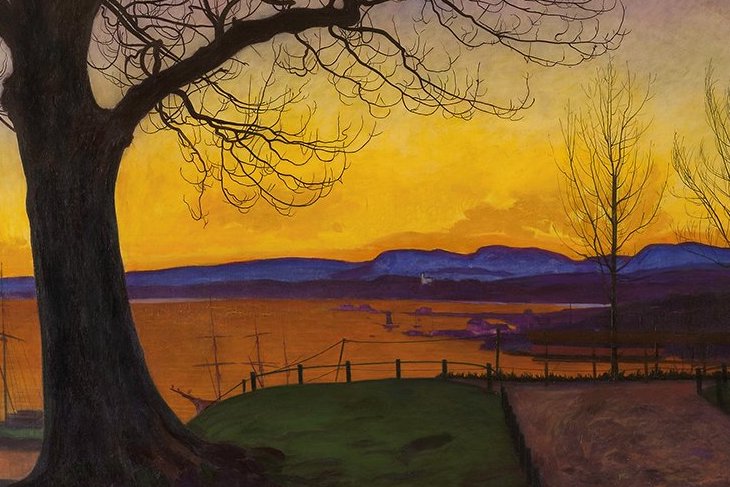
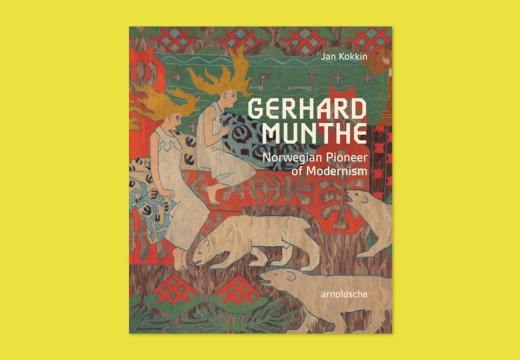
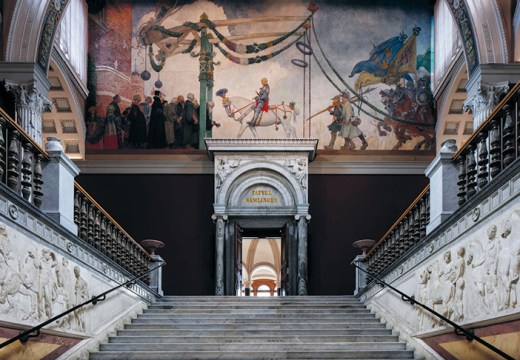
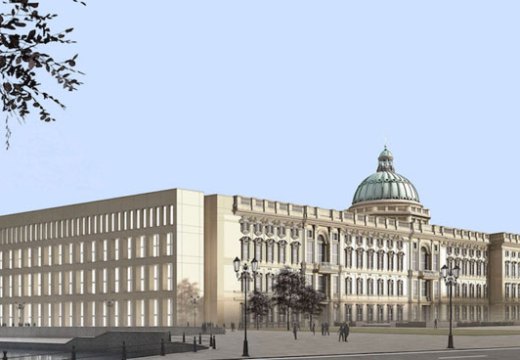









![Masterpiece [Re]discovery 2022. Photo: Ben Fisher Photography, courtesy of Masterpiece London](http://www.apollo-magazine.com/wp-content/uploads/2022/07/MPL2022_4263.jpg)
It’s time for the government of London to return to its rightful home